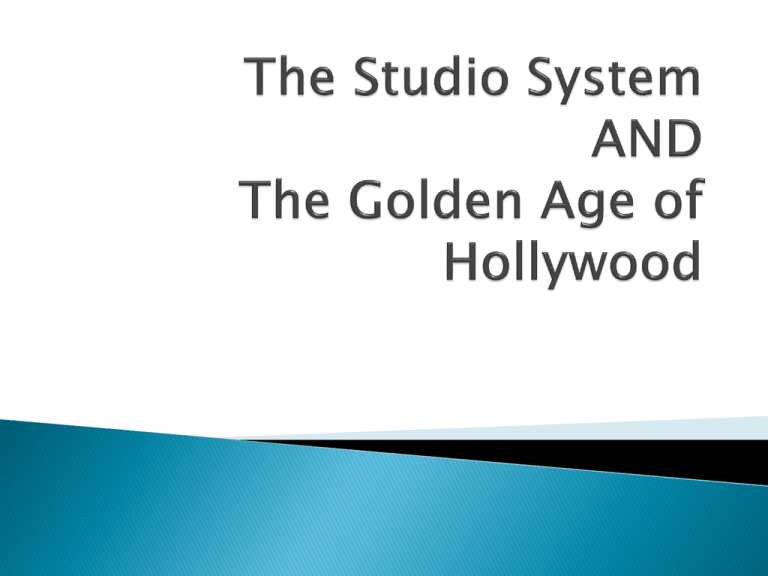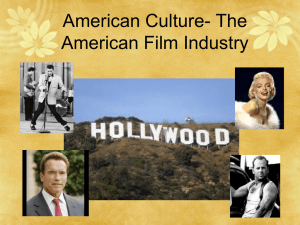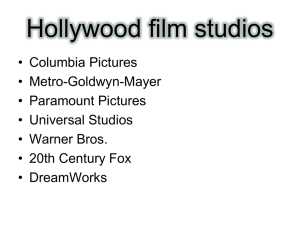Film History Part 3
advertisement

What was it? Essentially, the Hollywood Studio System was a way to mass produce movies Each studio was a massive lot that took up acres and acres of land Studios were complete with several different sets (Western town, New York Avenue, European Village, horror castle, etc) Also included in studios were any prop, costume, or piece of equipment one could ever need to make a movie As film grew more and more popular throughout the 1920’s, Americans demanded more quality films quicker The studio system was the answer—a way to mass produce movies in one area Eventually, five major studios emerged Paramount MGM This is a New York City street set from the 1920’s Warner Brothers Fox And RKO Costume designer Seamstress Hair Designer Set Designer Music director Technical Crew: ◦ Cinematographer (lighting) ◦ The Grip (Arranged the Set) Special Effects department ◦ Find ways to bring the impossible to life—King Kong, Oz, Frankenstein, etc Director ◦ Responsible for guiding the acting Producer ◦ Brought all the pieces together Oversaw the studio; had a final say on all decisions To the Right: Louis B. Mayer, head of MGM With the continued success of the film industry, dictators became very, VERY wealthy (and ruthful) The life of a Studio System Actor Actors were contracted to a studio and expected to make a certain number of films in a given time. Actors did not agree to how many hours they would work, and were at the mercy of the studio Ralph Bellamy was contracted to appear in thirteen feature films in one year; rebelled when he was asked to work straight through without a single days rest between films Actors had not formed Unions yet, so the studio held a lot of power 1927 Actors Equity Association tried to organize Mayer, against unionization of actors, formed the Academy of Motion Picture Arts and Sciences ◦ The Academy would be responsible for mediating any conflicts between actors and studios ◦ The idea never fully came to fruition; however, an awards show did come out of this ◦ 1933 Screen Actor’s Guild formed; has represented the stars since. (unions vs. guilds) Despite the harsh studio demands, many actors and actresses became household names Stars were read about in fan magazines During making of films, wore makeup to cover up any imperfections Movie stars represented escape for Americans, and offered different types of escape throughout the Golden Age of Hollywood. . . Rudolph Valentino ◦ Seen as the exotic hero for women ◦ The Shiek ◦ Represented the unreachable, romanticized ideal from a faraway land Gary Cooper, Clark Gable, Cary Grant All “Good Guys” who could be depended on to be brave and noble Handsome and manly More sophisticated, tougher hero Someone who became more cynical and less idealistic Humphrey Bogart Burt Lancaster Judy Garland Ingrid Berman Gene Kelly Most Famous Role: Singin’ in the Rain James Stewart Most Famous Role: It’s a Wonderful Life Studio System, through mass producing movies, did several things: ◦ ◦ ◦ ◦ Delivered volume of films to American people Created the Golden Age of Hollywood Turned actors and actresses into stars Made a ton of money in the process Moviemaking 4/13/2015 22 Film vs.Video 4/13/2015 As noted: Film stock is the imaging device for motion picture film CCD or CMOS is the imaging device for video 23 Picture resolution as discussed 4/13/2015 24 Major Movie Studios 4/13/2015 Paramount (including MTV Films, etc. -Viacom / CBS ) One of the oldest, largest and most well known movie production and distribution companies. Only studio IN Hollywood. Founded in 1912 by Hungarian-born Adolph Zukor. Currently owned by Viacom Inc. Paramount held the record for highest grossing film at the box office (unadjusted)--Titanic 1997 grossed $1,842,879,955 at the world wide box office, with a domestic total gross of $600,788,188. 25 Paramount Behind the Scenes... 4/13/2015 26 Paramount Behind the Scenes... 4/13/2015 27 Paramount Behind the Scenes... 4/13/2015 28 Paramount Behind the Scenes... 4/13/2015 29 Paramount Behind the Scenes... 4/13/2015 30 Major Movie Studios Warner Bros. -- Burbank, CA 4/13/2015 One of world's largest and most successful film producing and distributing companies. Originally founded in 1918 by four brothers, who were immigrants from Poland. The third oldest of Hollywood studios, and is one of the original pioneers in the film industry. 31 Major Movie Studios Sony Pictures Walt Disney (Buena Vista Distribution) Owned by News Corporation Universal 4/13/2015 Founded in 1923 by Roy & Walt Disney 20th Century Fox 1987, Columbia Pictures Entertainment (Columbia and Tri-Star Studios) NBC Universal. Now owned by Comcast. Founded in Los Angeles in June, 1912 by a German Jewish immigrant: Carl Laemmle 32 Other Movie Studios Dreamworks SKG (Spielberg) New Line Cinema Miramax 4/13/2015 Founded in 1967. In 1996 it became a subsidiary of Time Warner. In 2008, ceased independent operations as a movie studio / absorbed into Warner Brothers. founded by Harvey Weinstein and Bob Weinstein in 1979; bought by Disney in 1993, sold in 2010. Lionsgate 33 5 stages of moviemaking 4/13/2015 Filmmaking vs. moviemaking Development Pre-production Production Post-Production Distribution and exhibition 34 Development 4/13/2015 Who can pitch, to whom do you pitch, optioning a script / step deal The script is written and drafted into a workable blueprint for a film Decisions made about stars (‘packaging’) and initial casting, location, budgets Who is calling the shots? 35 Development steps... 4/13/2015 Producer finds a story (from...) After identifying a theme or underlying message, the producer works with writers to prepare a synopsis They produce a step outline, (or scene outline) breaking the story down into one-paragraph scenes that concentrate on dramatic structure Then, they prepare a treatment, a 25 to 30 page description of the story, its mood, and characters ‘Notes’ along the way 36 Development 4/13/2015 Next, a screenwriter writes a screenplay over a period of several months. The screenwriter may rewrite it several times to improve dramatization, clarity, structure, characters, dialogue, and overall style. Other writers may be brought in. BUT, Producers often skip the previous steps and develop submitted screenplays -- which investors, studios, and other interested parties assess through a process called script coverage. 37 Development... A film distributor may be contacted -assess the likely market and potential financial success of the film. Hollywood distributors consider: 4/13/2015 the film genre, the target audience, the historical success of similar films actors who might appear, potential directors. All these factors imply a certain appeal of the film to a possible audience and hence the number of "A.I.S." during the theatrical release. 38 Development... Not all films make a profit from theatrical release -- DVD sales and worldwide... Producer & screenwriter prepare a pitch and present it to potential financiers. If the pitch is successful, the film (or TV show) receives a "green light” 4/13/2015 May be ‘optioned’ The parties negotiate a deal and sign contracts. Once the deal is set, the film may proceed into the pre-production period. By this stage, the film should have a clearly defined marketing strategy and target audience. 39 Pre-production 4/13/2015 Preparations are made for the shoot Cast and crew are hired UPM -- script breakdown Locations are selected Sets are built Equipment secured / leased Script re-writes and staff 40 Pre-production 4/13/2015 The production company is created and a production office established. The production is storyboarded and visualized with the help of illustrators and concept artists. A production budget is drawn up to plan expenditures for the film. 41 Production 4/13/2015 Actual shooting of the raw elements Crew members sharing the ‘Director’s Vision’ Call sheets etc Studio stages, Locations, department heads, 2nd units 42 Post-Production 4/13/2015 Transfer to digital, then editing Dialogue editing / including ADR Music tracks (and songs) composed, performed, recorded Scenes are scored Sound effects are designed and recorded Computer-graphic 'visual' effects are digitally added, All sound elements are mixed into "stems," then the stems are mixed, then married to picture The film is fully completed ("locked") 43 Once Locked... 4/13/2015 The film is passed into the hands of the postproduction supervising sound editor to layer the sound track. Voice recordings are synchronized The final sound mix is created by the rerecording mixer. The sound mix combines dialogue, sound effects, ADR, walla, Foleys and music. 44 Sales and distribution 4/13/2015 The film is screened for potential buyers (distributors) It is picked up by a distributor and reaches its cinema and/or home media audience. Promotion and marketing -advertising, actor appearances, etc. $$$ ‘Straight to DVD’ ? 45 Major Positions Above the line -- $$ Residuals / owners Producer, Director, Writer, Actors Producer 4/13/2015 Hires a crew The nature of the film and the budget, determine the size and type of crew used during filmmaking Many Hollywood blockbusters employ a cast and crew of hundreds A low-budget, independent film may be made by a skeleton crew of eight or nine (or fewer). 46 Director 4/13/2015 Primarily responsible for the storytelling, creative decisions and acting of the film. Established versus emerging directors Film school graduates ‘Author’ of a movie, while the Producer is ‘author’ of a TV show ‘Director’s cuts’ of movies 47 Famous TV Producers / Movie Directors 4/13/2015 Dick Clark, Gene Roddenberry, Norman Lear, Aaron Spelling, Jerry Bruckheimer, Chuck Lorre... Steven Spielberg, Spike Lee, Oliver Stone, James Cameron, George Lucas, Ron Howard, Tim Burton, JJ Abrams... 48 Below the Line 4/13/2015 Director of Photography (DP) The cinematographer who supervises the photography of the entire film A chief over the camera and lighting crews working on a film Responsible for achieving artistic and technical decisions related to the image Some professionals insist that the term cinematographer only applies when the director of photography and camera operator are the same person 49 Unit Production Manager (UPM) 4/13/2015 Responsible for watching all the costs--to deliver the project on budget at the end of principal photography. Lead dept. managers, script breakdown. Producers responsible for cost-related decisions on above-the-line (primarily, casting) issues; UPM responsible for below-the-line (primarily, production period) costs. The film’s director has the final say on the cinematographer, costume designer, production designer, and film editor; UPM makes the deals and hires the remaining crew. 50 Production Coordinator 4/13/2015 Serves under the UPM to coordinate the various groups and personnel that come together to make a movie or TV show. Requires organizational skills and the ability to handle a multitude of tasks simultaneously under often highpressure situations. Duties are often undefined and extremely varied ranging from office manager, to human resources, to controller, to accountant. 51 Other major positions 4/13/2015 Casting Director Location Manager Line Producer Production Designer * Sound Designer Art Director Editor * 52 Discussion 4/13/2015 How much control does a Producer have on a project? How much control does a writer have on the actual implementation and production of a script (s)he has sold to a Producer? How involved is the Director typically in casting a film? (more) 53 Discussion 4/13/2015 What is involved in Production Design? What is involved in Sound Design? What is and how important is product placement? How important is casting? Does the director direct talent or crew? What are some issues about location shooting? 54




![[Lecture 19] studio system 2 for wiki](http://s2.studylib.net/store/data/005217793_1-c296c1b3b7b87d52a223478e417a702f-300x300.png)

